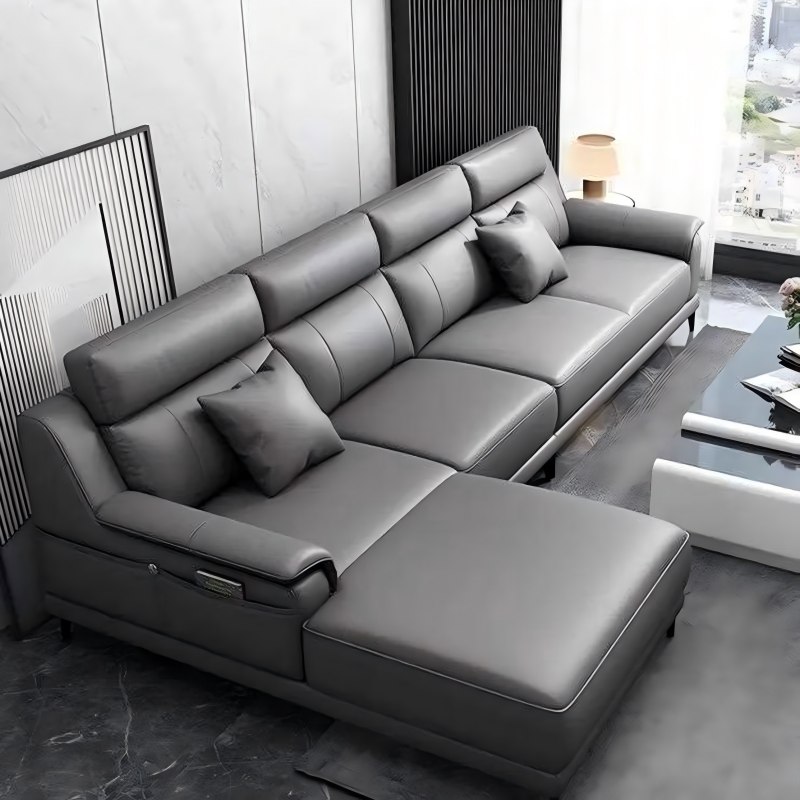The Ultimate Guide to Buying Leather Sofas: The Scientific Truth Behind Luxury
要旨
Leather sofas symbolize high-end home quality, but they hide usage traps. This article combines material science, environmental certification, usage scenarios and market data to deeply analyze its six core dimensions: Essence of comfort, Maintenance cost, Environmental and health risks, Pets and climate adaptability, Long-term value and Comparison of alternative materials, and cites authoritative standards such as the EU REACH regulations and the French A+ certification to help consumers make rational decisions.

1. Material: Double game between luxury and practicality
The core value of leather sofas comes from the leather grade:
- First-layer cowhide (especially yellow cowhide) retains natural pores and has excellent breathability. The surface temperature in summer is 2-3℃ lower than that of fabric, but the cost accounts for 35%-40% of the total product price;
- Second-layer leather has improved wear resistance after coating, but its breathability drops sharply, and it is easy to harden and crack due to changes in temperature and humidity;
- Embossed leather (such as lychee pattern) covers scars through mechanical pressing, which is cost-effective, but sacrifices the skin-friendly touch of genuine leather.
Key data: The risk of peeling of buffalo leather after one year of use is as high as 60%, while the life of first-layer yellow cowhide can reach more than 15 years.
2. Comfort: the victory of scientific filling and ergonomics
The comfort of leather sofas depends on the coordination of filling and structure:
- High-density sponge + down mixed filling balances support and wrapping, and layered technology reduces hip pressure by 18%;
- Pine frame + serpentine spring has a lifespan three times longer than cheap wave springs, avoiding the risk of collapse;
- Misunderstanding warning: People with thin bodies need to choose backrests with adjustable tilt, otherwise the side support may compress the lumbar spine.
Authoritative advice: According to the test results of the Shanghai Quality and Technical Supervision Bureau, 48% of sofa fillings have excessive formaldehyde. When purchasing, you need to ask for the French A+ certification (TVOC≤0.06mg/m³) or the American CARB-NAF report.
3. Maintenance cost: invisible investment beyond imagination
Leather maintenance is a “luxury game” that requires continuous investment:
- Professional care agents are three times more expensive than ordinary cleaners, and the annual maintenance fee accounts for 5%-8% of the sofa price;
- Three avoidance principles: avoid high temperatures (>40℃), avoid strong acids (pH<3), and avoid oil stains – coffee stains that stay for 15 minutes will make cleaning four times more difficult;
- Pet families need to add anti-scratch kits (warp and weft density>500T) and citral repellent, otherwise cat claws will scratch 50 times a day for half a year and scars will appear.
Case: Pets with untrimmed nails can instantly invalidate the critical value of leather tear resistance (200kPa).
4. Environmental Protection and Health: Hidden Threats of Chemical Residues
Leather processing hides chemical risks:
- Hexavalent chromium (EU limit ≤5mg/kg) and formaldehyde (national standard ≤75mg/kg) are easily exceeded in the tanning process, and the chromium content of some domestic products reaches 5-8mg/kg;
- Solvent N,N-dimethylformamide (DMFa) can cause contact dermatitis, and the EU will limit its concentration to ≤0.1% from 2023;
- When purchasing, you must look for EKO-TEX ecological certification or FSC forest certification to ensure that the formaldehyde emission is ≤0.03mg/m³.
Self-test method: If the irritating smell of a new sofa persists for more than 2 weeks after opening, the DMFa residue may exceed the standard.
5. Climate adaptability: Region determines lifespan
Genuine leather is an “environmental sensor”:
- High humidity environment (humidity>65%) is prone to mildew, and the Yangtze River Basin needs to be dehumidified for 4 hours a day to maintain humidity at 45%-55%;
- Dry heating areas (such as Harbin) have a cracking risk of 11 times that of Guangzhou when the moisture content of leather is <12%, and a humidifier must be used;
- Solution: Oil wax leather (humidity resistance) is preferred in the south, and Nappa leather (ductility and anti-cracking) is recommended in the north.
6. Substitutes vs. genuine leather: game under technological innovation
New materials such as microfiber leather impact the high-end market:
- Microfiber leather has a tear strength of 60N·m (80% of genuine leather), and the price is as low as 1/3, but the crack area is 3 times that of genuine leather after 5 years;
- Nano-coated imitation leather has a 40% increase in breathability and 90% crocodile pattern imitation accuracy, but there is a problem of a sharp drop in color fastness;
- Investment attributes: The 10-year residual value rate of a properly maintained genuine leather sofa is 35%, far exceeding that of fabric (<10%), and the auction price of Italian antique models is 12 times the original price.
Summary: The golden rule of rational investment in high-end home furnishings
革張りソファ are the choice of long-termists – it uses high costs (purchase price + maintenance) in exchange for unrepeatable texture and durability, but is highly sensitive to the environment, pets, and regions. Rational decision-making should follow:
- Inspect the material: insist on top-layer yellow cowhide, and ask for a leather sample test report;
- Certification: French A+ (VOC), EU REACH (DMFa), FSC (Environmental Protection Framework) three certificates escort;
- Matching scene: choose open painted leather in humid areas, and install anti-scratch cover for pet families;
- Total account: 10-year use cost = purchase price × 1.6 (maintenance fee), which is lower than the total cost of frequent replacement of fabrics.
Ultimate suggestion: offline experience seat depth, back height, and filling rebound (such as Yueying Home Furnishing Store), and beware of the “full leather” text trap when comparing prices online-the contact surface leather ≠ full leather.
Authoritative citation: EU REACH Regulation | French VOC A+ Standard | FSC Certification System
